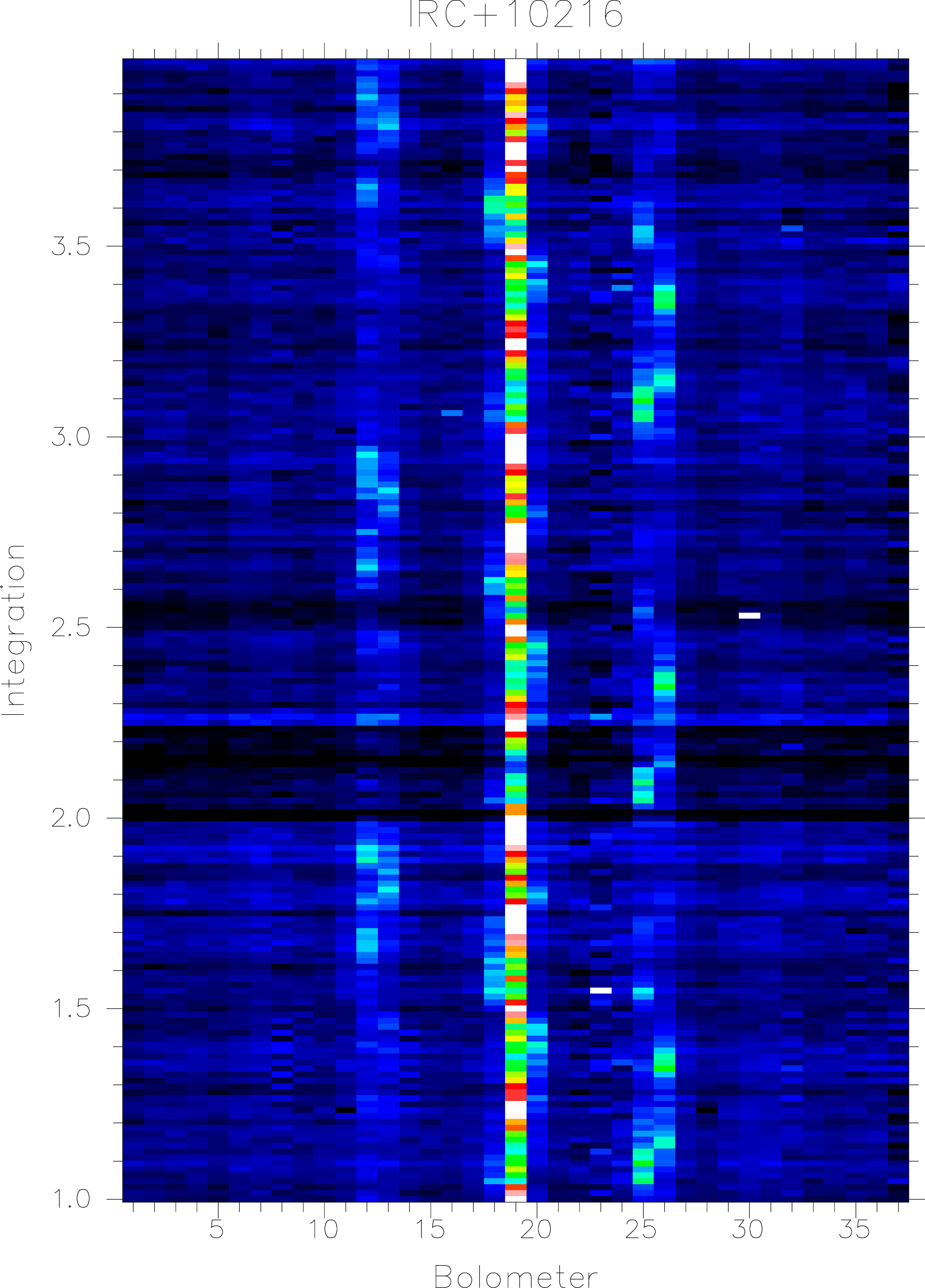

From the plot shown in Fig. 2 we can see that the map suffers from some sky noise, e.g. visible as the dark striping at the beginning of integration 2. The central bolometer, 19 (h7) shows a clear signal, and we do not see any really bad (noisy) bolometers, except perhaps bolometer 23. Even so, we first need to blank out bad bolometers. There are several ways to identify bad bolometers. The easiest way, although it may not pick up all noisy bolometers for your particular map, is to run scunoise, which is a GUI that allows you to plot and identify all noisy bolometers using noise measurements done during the run. If we do this for the night of 19971208 we find a total of 9 noise measurements and we can see that some bolometers come and go, but 23 is always noisy. From the most nearby noise measurement, #88, we find that 23, 32 and 37 have noise levels above 100 nV and 12 is also about twice as noisy as the majority of the array, which should have a noise level around 40 nV. Before we set these bolometers to bad we plot the bolometers with mlinplot to check that these bolometers are indeed noisy in our map.
In the above example the bolometers 21 – 32 are plotted as a function of integration time (Fig. 3).
Bolometer 23 is indeed the noisiest pixel, but 22, and 24 are noisy as well and actually
worse than 32, which was picked up by scunoise. Fig. 3 shows strong sky noise, which
makes it difficult to see the true noise level of the bolometers, and it is often wise to do a
sky noise reduction (see below), so that one can more easily identify noisy bolometers.
Go through the whole array by choosing suitable bolometer ranges with the parameter
lnindx. In this example we choose to only blank out bolometer 23, which we set to bad
using change_quality. Bolometers 8 and 14 also appear noisy, more so than 12, which we
picked up in the noise measurement, but for the time being we let them stay. When we
go through the bolometers with mlinplot we can also see a few spikes, which we will
deal with shortly. Let us now set bolometer 23 with change_quality. Note that we need
to surround the file name with both single and double quotes if we list more than one
bolometer.
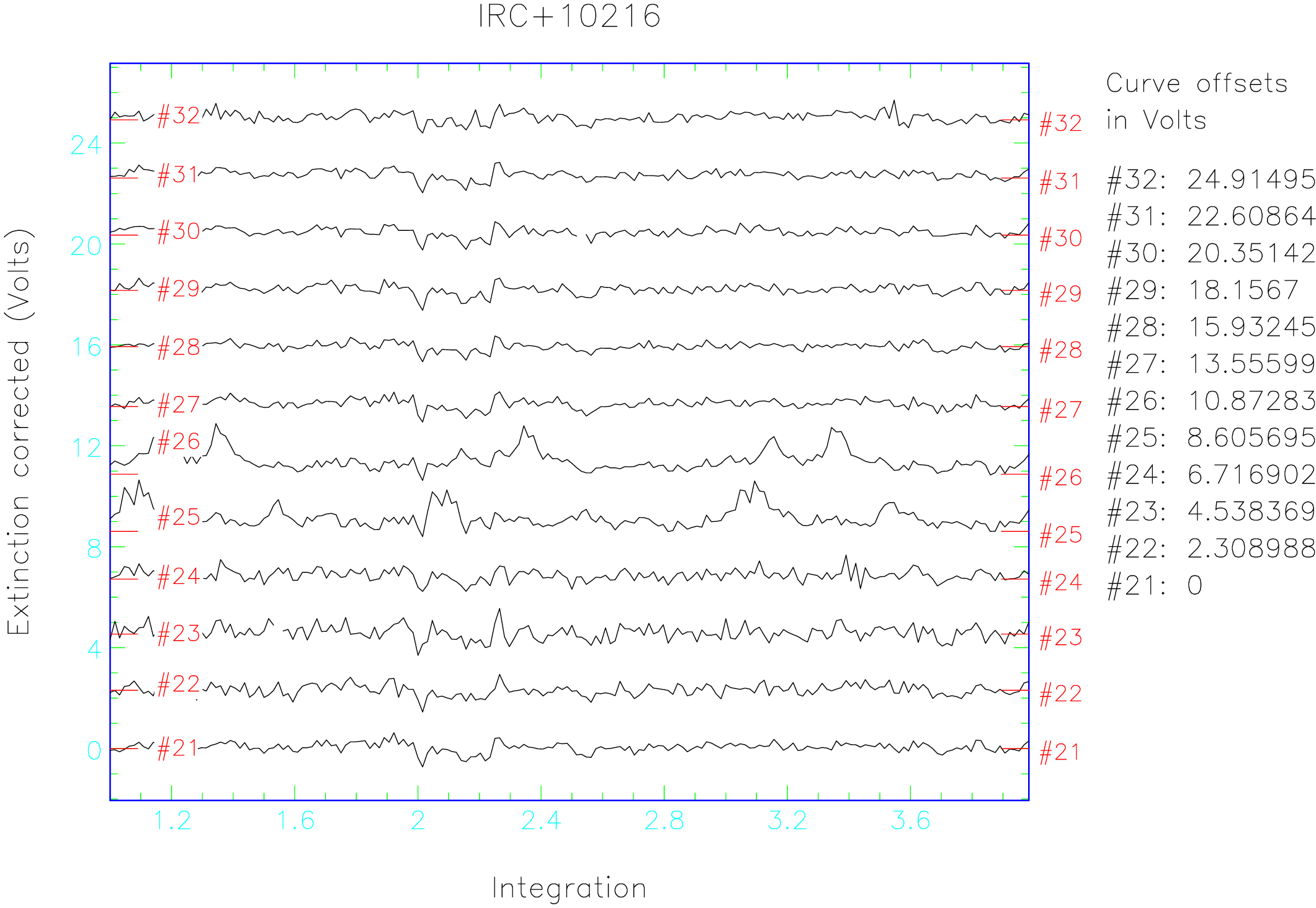
As we have already seen, sky noise can be a dominant noise source in a map, but as long as the sky noise is correlated over the array, it can be removed. One can do this in several different ways, but for a single short integration map one will always use remsky. In the automated SCUBA reduction Jenness et al. [14] use the median option in remsky and include all bolometers. Since we have a centrally symmetric source, we take the second ring, r2, of bolometers using the median option to avoid spikes that may be present in the data.
Note that the default behavior of this routine is to add the mean bolometer signal back in to data (this may not be what you wish to do) if it’s not then type:
Let us now remove the worst spikes by using the Surf task scuclip to take out any spikes exceeding 5 sigma.
scuclip removed 3 spikes in the data, which will do for the moment.
Following despiking and sky removal one can then run rebin. The process of sky removal will significantly improve any maps which have a ‘tiled’ pattern due to varying sky emission between the two switch positions. Below we discuss in more detail how to most efficiently remove sky noise, which depends on what data sets we have.
In Section 5.2 we already used remsky to remove sky noise by choosing a ring of bolometers around the center and we could even have used all bolometers in the array. However, for short chop throws, or where we have an extended source or where the source is not centered in the array one should be more careful. A good way to identify suitable sky bolometers (i.e. bolometers without any source emission) is to convert the map into Az/El (assuming we chopped in Az) so that we can identify bolometers at the edge of the array, which are not affected by the chop nor by any source emission. We regrid the extinction corrected data with the Surf task rebin, setting the parameter to az. In the example below we use the same data set on IRC10216 as we used before. We plot the map immediately with display using the option faint and overlay the bolometer array using scuover (use noname if you want the bolometers as numbers).
IRC10216 is extended at 850m, because of its large CO envelope, and we therefore want to use edge pixels away from the chop direction (usually az) to avoid removing any real signal from the data. In our map of IRC+10216 (Fig. 4) one would therefore take bolometers 4,9,15 and 22 in the south and 16, 29, and 34 in the north. If we now run remsky on the extinction corrected data, we notice that the background level added back to the map was lower than when we used ring 2, which therefore picks up some of the faint extended emission surrounding IRC10216.
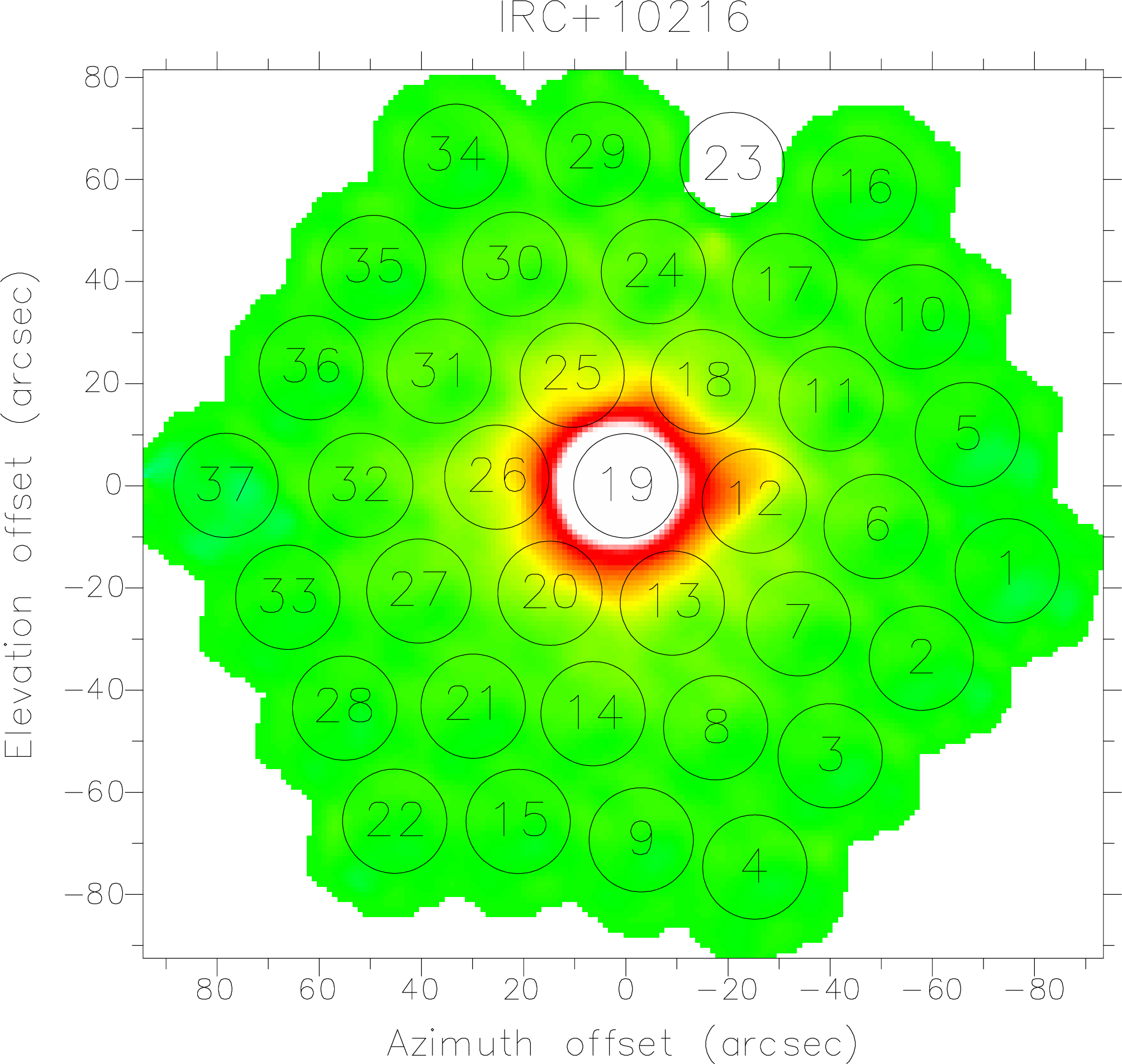
Quite often, especially when we observe galactic sources embedded in dark or molecular cloud, it is
impossible to find any bolometers that do not pick up source emission. As long as the
source emission is relatively smooth, this will only affect the mean level in the map, and
any base level that gets removed with remsky can be added back into the image using
. But, if
there is structure in the source emission over our sky bolometers, these variations will be
interpreted as sky noise and therefore affect the morphology of our map. For extended
sources we should therefore use calcsky. The task calcsky computes a model of the source,
which it then subtracts from each bolometer to give an estimate of the sky variation, which
is put into the file extension .more.reds.sky, which can be examined with e.g. linplot,
e.g.,
shows the computed sky noise variations for the scan 86, that we will re-analyze below (Fig. 5).
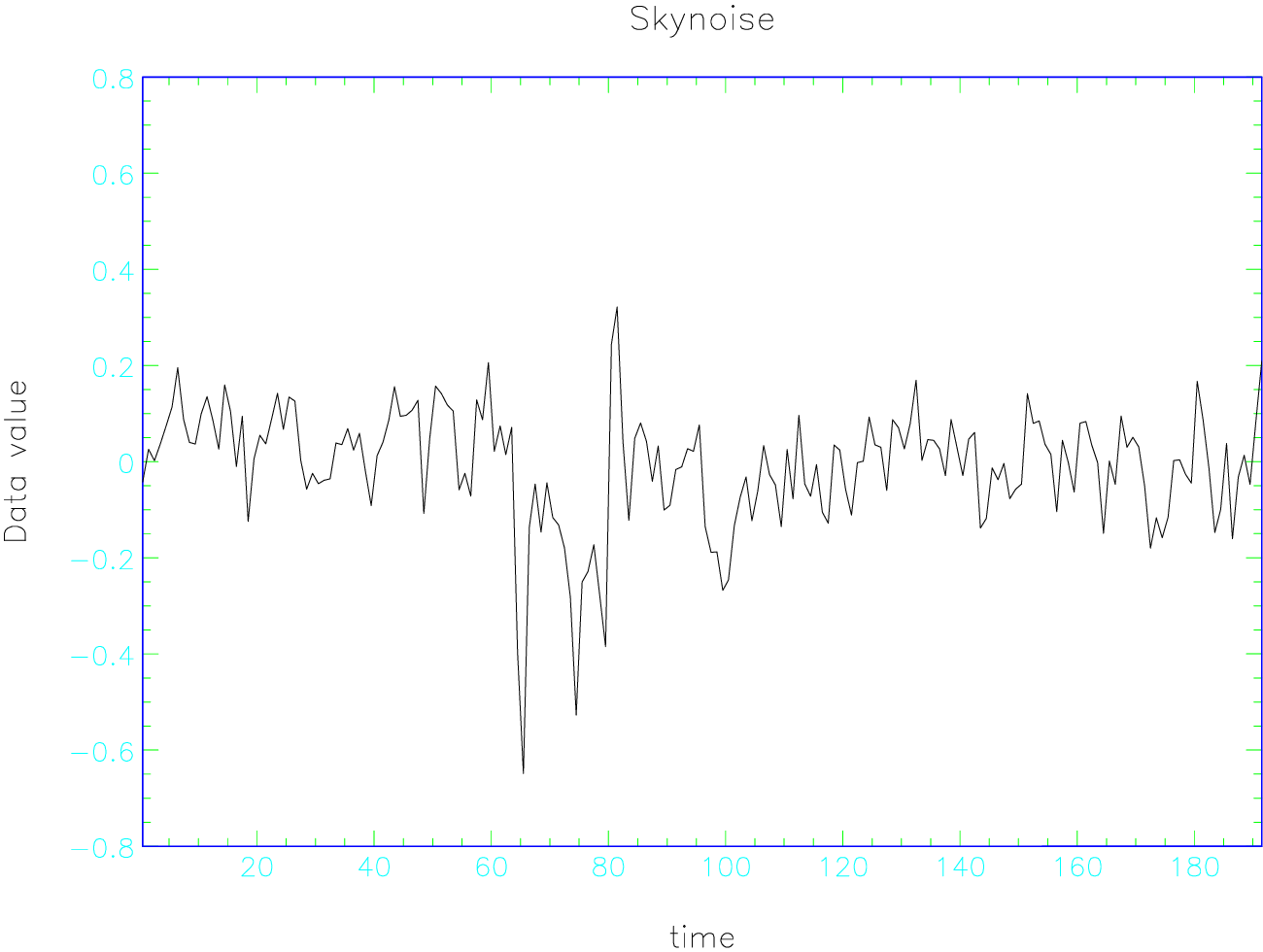
We can improve the model by adding data sets to calcsky the same way as we use rebin for coadding data. If one has already produced a final map of the source, one can use this map as the input model for calcsky. For multiple data sets we should make an input file with weights and offsets as we do for rebin, see Section 5.8. We now choose the default model, which will be the median of all the observed maps. Once calcsky is done, we go back and run remsky on each data file which was included in the model computed by calcsky.
calcsky works extremely well even for extended sources, if one has kept the chop position fixed. For extended sources it is therefore an advantage to chop in a fixed ra/dec frame. One can also use calcsky for a spherically symmetric source like IRC10216 even for a chop throw of 60”, but then one should use az option for the . calcsky also includes the option to account for the chop throw and direction, and it should therefore work even when we chop differently on extended emission from one map to the next.
For scan maps calcsky is our only option for sky noise removal, because in scan maps each bolometer will normally include both source and sky (see later).
Below we show how to use calcsky on the same file we already reduced with remsky. When we now run remsky it will not ask for sky bolometers, but will use the sky extension stored in the header to remove sky noise variations.
The sky noise we see in our jiggle maps is due to changes in the sky emission between nods of the telescope. For unstable sky conditions this results in a tile-pattern in your map. This type of structure will not be removed by calcsky if we apply it to a single data set. Indeed in this particular example, remsky with selected sky bolometers gave a much better result than using calcsky. However, for really extended sources and scan maps we may not have a choice. We will have to use calcsky followed by remsky.
Another advantage of calcsky which is worth mentioning is that we can run calcsky on the 450m array and copy the calculated sky noise variations to the 850m array after appropriate scaling. This enables us to remove sky noise variations on a very faint extended 850m–source, without subtracting out source emission.
The way we despike jiggle maps depends on whether we have done short or long integrations and on whether our source is compact or extended. In the above example we only have 3 integrations and despike will miss most spikes. We can still use scuclip but if we want to go deep, we have to make sure that we don’t clip the source as well. We know that IRC10216 is relatively compact with a faint ‘halo’ type emission surrounding the core. It may therefore enough to use scuclip, but go deeper than in our initial despike effort. To be on the safe side, i.e. to make sure that we do not clip the source, we set the central bolometer to bad before we start and reset it back to good afterwards using change_quality.
Compared to our first 5 sigma we now found 10 additional spikes. We could probably have used 3 sigma, but with a small data set it is better to be conservative, For the short array, we have to be really careful when using scuclip, if we work with 64–point jiggle maps. If we are looking at a point source centered in the array, the jiggle steps are so large, that the first ring of bolometers will pick up the source in part of the jiggle pattern. scuclip can in this case interpret the source as being noise, since it only shows up in a just a couple of points, and flag them. The end result can easily be that when we regrid the map, we get an artificially narrow image, because we despiked the “flanks” of the source. If we want to run scuclip on the short array, we should not only blank the central bolometer, but also the first bolometer ring (seven bolometers), and then reset the flagged bolometers afterwards and despike them manually, which becomes somewhat tedious.
For short maps on strong or extended objects we therefore mostly end up doing manual despiking. We can either use the interactive shell script dspbol or the Figaro routine sclean.
which will give you an image similar to Fig. 6. sclean is an interactive application and if you select the xwindow, and type ‘b’ while the cursor is over a selected bolometer you will get the display shown in Fig. 6. Here the left hand side shows all the bolometers, and the right hand side shows just the bolometer you selected. The two most useful commands are probably ‘a’ - delete the pixel selected, and ‘y’ - delete the indicated area and fix by interpolation along the y-axis. Manual despiking like this is usually only needed for short integration maps of strong sources or when taking out more extended glitches in scan maps, which are not picked up by automatic despiking.
Before we create our final rebin, we will still need to calibrate the map (Section 7) and correct for pointing drifts that occurred over the map. Since we have only dealt with a single map so far, we omit the calibration stage and proceed to correct for pointing drifts. To do this we reduce the closest pointing observations before and after the map in the same way as we reduced our map, but with minimal despiking and regridding the pointing map in az. These pointing errors we find have to be negated in the task change_pointing. For scan 86 I find one pointing done on the star itself before the map (#81), and none afterwards. The final pointing errors of # 81 are DAZ/DEL = 0.38”/+0.33” at an LST of 9:26 as deduced from the FITS header of that scan. These errors are the residual from on-line pointing corrections and off-line data reduction of scan 81. If we treat our map as if it was a pointing observation we find pointing errors of +1.52”/+0.12”, which we apply directly after negating the sign as shown below. Instead of choosing a time halfway through the map, we have to take the LST time at the end of the map. This is kind of cheating, because we derive pointing from the same objects that we are supposed to correct the pointing for, but here we do it only to illustrate how pointing corrections are done.
We can now run the sky noise corrected, despiked, and pointing corrected data through rebin to obtain our final map i86_lon_reb. Looking at the map, we can see that bolometers, which we knew were noisy still can be seen, but since we do not have any additional data sets to add to the map, we will leave the map as such. The pointing offsets, as determined with centroid give pointing offsets of -0.18” in RA and 0.0” in Dec, suggesting that the pointing corrections worked quite well.
Now we would do the short array in the same way either by re–running scuquick or by starting
with the Surf task extinction. We now run extinction on i86_flat, which was created
when we reduced the long array, and which also contains the flat fielded data for the short
array.
Reducing multiple observations of the same source is about as easy as reducing a single map, it is just a bit more time consuming. Some aspects of the reduction process, like despiking, now becomes simpler and more reliable.
All the basic steps up to and including sky removal are done the same way as in the example above, but now we can despike differently, because we have much more redundant data. After we have extinction corrected, calibrated, done sky removal and pointing corrections we can now try despike on all the data sets.
To demonstrate despike we have collected 10 jiggle maps with two or three integrations of HL Tau,
one of our secondary calibrators. All the maps are taken in good weather conditions, but some suffer
from sharp variations in sky noise. We have set the really noisy bolometers to bad for all maps, but in
some cases we have still left bolometers with 1.5 - 2 times the average noise level. For all maps the
chop throw was 120" in Azimuth. Note that if you chop on the array this despiking technique will not
work very well, unless you use a fixed chop angle, or regrid in az which works very well for a point
source or a centrally condensed spherically symmetric source. To make the reduction easier, and to
enable us to go back and redo the despiking, we make a small ASCII file for the maps,
which includes the name, weight and pointing shift – one line per map. Here we start
without applying pointing corrections because the pointing errors are negligible. Neither
do we apply weighting, because we will need despiked maps in order to compute the
weights. In this example we call the file hl.inp. The first line in this file is hl39_lon_sky 1
0 0, where hl39_lon_sky is the file name and 1 is the weight. The two zeros that follow
the weight are the pointing shifts in the coordinate frame that the data are rebinned to,
which in this case RJ. Since HL Tau is a point source with negligible extended emission
one could equally well have rebinned the whole data set in az. We are now ready to try
despike.
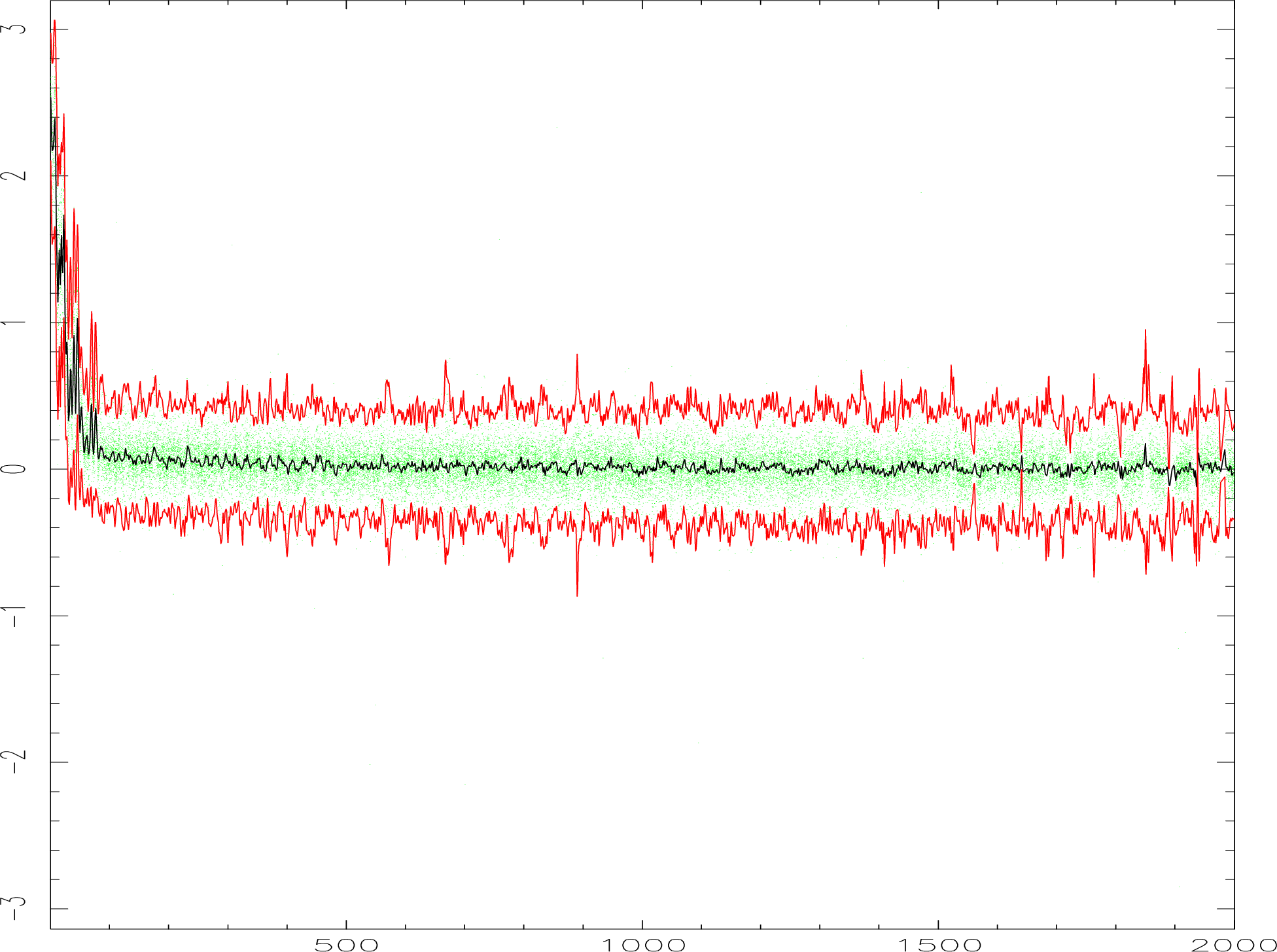
The display for the first 2000 data points are shown in Fig. 7. Note that after you run despike the
display may get messed up. It is normally sufficient to clear the display with gdclear and re-issue the
the color table, e.g. lutbgyrw. If there are still problems, delete the AGI-file from your home directory
(agi_xxx.sdf, where xxx is the name of your work station).
We now run rebin on each data set to determine the offsets we need to center the map, which will
ensure that we get the sharpest possible image. We also determine the rms noise level for each map.
Here it is a clear advantage to use Gaia. After displaying the map with your preferred color
scheme and contrast level using the View menu, go to the Image-Analysis menu and click
on image regions. Choose the polygon option of ARD regions and outline the region you
want to use with the cursor. After it is done, click on Stats selected and you are done. For
determining pointing offsets it is easier to use the Kappa command centroid i.e. centroid
search=19 cerror, where we adjust the search parameter to minimize the fit errors. For
850 m
and a 1 arcsec cell setting search to 17 or 19 generally gives a good result. After we have
determined the noise level and position offsets for each map we compute the weights for
each map. An easy way to do this is to set the weight for the first map equal to one. All
other maps are then weighted relative to this map. If we call the integration times
t and
t, and the corresponding
noise values n
and n
for map 1 and map 2 respectively, then we can compute the weighting factor from the following
equation:
| (3) |
We now edit in the weights and position offset in hl.inp and run despike again on the original data
set. The end result appears good enough.
Now we can form the final co-add of the data very easily, since we have already computed the
weights and position shifts that we need to get the best S/N and sharpest image from our data. The
only thing we need to do is to change the file extensions from sky to dsp, the name we used for
despiked data files. We rename the input file to hl.dsp in case we would like to redo the despiking.
We now run this file through rebin, i.e.,
We now have our final co-added map, which is almost as good as it can get from the data we had available.
If you have extremely large data sets, then you may find that your computer runs out of memory in rebin. The recommended solution, if you cannot find a more powerful workstation, is to split the data set in two parts, run each separately through rebin, and co-add the two final maps using the Kappa command add or the task makemos in Ccdpack.